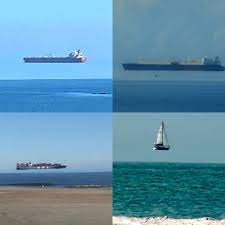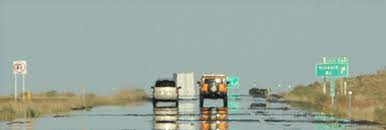Imagine you're in the desert. You're lost. You've been walking for hours. You've run out of water. On the horizon, you see a giant, shimmering puddle of water. "Yippeeeeeeeeee", you shout. You're saved!
But...it's not a puddle of water. It's a mirage.
Mirages are optical illusions that have fooled many thirsty explorers.
How do mirages form?
Mirages have nothing to do with water at all. It’s all about how light travels through the air. Normally, light waves from the sun travel straight through the atmosphere to your eye. But, light travels at different speeds through hot air and cold air.
Mirages happen when the ground is very hot and the air is cool. The hot ground warms a layer of air just above the ground. When the light moves through the cold air and into the layer of hot air it is refracted (bent).
A layer of very warm air near the ground refracts the light from the sky nearly into a U-shaped bend. Our brain thinks the light has travelled in a straight line.
Our brain doesn’t see the image as bent light from the sky. Instead, our brain thinks the light must have come from something on the ground.
The words "mirage" and "mirror" come from the same root word, which means "to look at."
Normally, light travels in a straight line, but it will change direction depending on what it passes through. This bending is called "refraction." Gases, such as air, become thinner as they get warmer. As a result, light tends to curve (or refract) towards the colder layer of air. This makes the image appear to come from a different direction than the original object.
There are two basic types of mirage, depending on which direction the temperature changes, inferior and superior.
Inferior
An inferior mirage is arguably the most common type seen over land. The air near the solid ground is typically warmer than the air above it. When light from the sky passes through it, a shimmering, fragmented image of the sky may appear to come from the ground, resembling water.
Superior

Sometimes a mirage can appear to come from higher up than the original object. When the colder air is lower (called an inversion layer), as it often is over large bodies of water or ice, the apparent direction of the mirage will be opposite that of an inferior mirage. For example, a distorted image of a ship or an island may appear on or above the surface, even if the original object is hidden below the horizon.
A "Fata Morgana" is a complex superior mirage whose appearance can change quickly and dramatically. Its name refers to Morgan le Fay, a mythical enchantress strongly associated with Arthurian legends. In times past, the disturbing images seen as part of the mirage were attributed to illusions created by magic.
Artificial
A mirage-like effect can be achieved by allowing a soluble substance like sugar or salt to slowly dissolve in a deep container of water so that there is more sugar in the water near the bottom than in the water above it. This can refract the image of an object seen through it, similarly to a superior mirage often seen over open water.
In contrast to a hallucination, a mirage is a real optical phenomenon that can be captured on camera, since light rays are refracted to form a false image at the observer's location.
